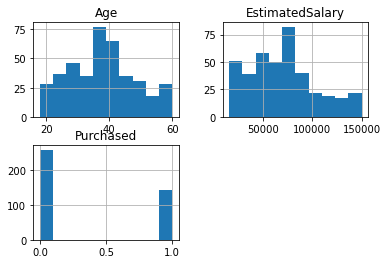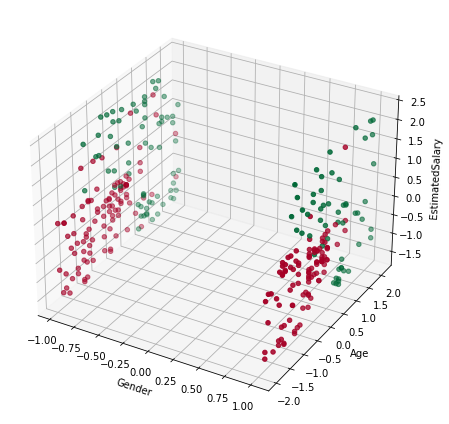Práctica - clasificación¶
import pandas as pd
import numpy as np
import matplotlib.pyplot as plt
from sklearn.preprocessing import StandardScaler
from sklearn.linear_model import LogisticRegression
from sklearn.svm import SVC
from sklearn.tree import DecisionTreeClassifier
from sklearn.metrics import accuracy_score
from matplotlib.colors import ListedColormap
from sklearn import tree
Lectura de datos:¶
df = pd.read_csv("Social_Network_Ads.csv", sep=",", decimal=".")
print(df.head())
User ID Gender Age EstimatedSalary Purchased
0 15624510 Male 19 19000 0
1 15810944 Male 35 20000 0
2 15668575 Female 26 43000 0
3 15603246 Female 27 57000 0
4 15804002 Male 19 76000 0
Información de cada columna de la base de datos y cantidad de valores nulos:
df.info()
<class 'pandas.core.frame.DataFrame'>
RangeIndex: 400 entries, 0 to 399
Data columns (total 5 columns):
# Column Non-Null Count Dtype
--- ------ -------------- -----
0 User ID 400 non-null int64
1 Gender 400 non-null object
2 Age 400 non-null int64
3 EstimatedSalary 400 non-null int64
4 Purchased 400 non-null int64
dtypes: int64(4), object(1)
memory usage: 15.8+ KB
Cantidad de distintos elementos por columna:
df.nunique()
User ID 400
Gender 2
Age 43
EstimatedSalary 117
Purchased 2
dtype: int64
Identificar cada fila como el ID:
df.set_index("User ID", inplace=True)
print(df.head())
Gender Age EstimatedSalary Purchased
User ID
15624510 Male 19 19000 0
15810944 Male 35 20000 0
15668575 Female 26 43000 0
15603246 Female 27 57000 0
15804002 Male 19 76000 0
Análisis de las variables:¶
df.hist()
array([[<AxesSubplot:title={'center':'Age'}>,
<AxesSubplot:title={'center':'EstimatedSalary'}>],
[<AxesSubplot:title={'center':'Purchased'}>, <AxesSubplot:>]],
dtype=object)

print(df.describe())
Age EstimatedSalary Purchased
count 400.000000 400.000000 400.000000
mean 37.655000 69742.500000 0.357500
std 10.482877 34096.960282 0.479864
min 18.000000 15000.000000 0.000000
25% 29.750000 43000.000000 0.000000
50% 37.000000 70000.000000 0.000000
75% 46.000000 88000.000000 1.000000
max 60.000000 150000.000000 1.000000
Transformación de atributos categóricos:¶
df.value_counts("Gender")
Gender
Female 204
Male 196
dtype: int64
from sklearn.preprocessing import LabelEncoder
gender_encoder = LabelEncoder()
df["Gender"] = gender_encoder.fit_transform(df["Gender"])
print(df.head())
Gender Age EstimatedSalary Purchased
User ID
15624510 1 19 19000 0
15810944 1 35 20000 0
15668575 0 26 43000 0
15603246 0 27 57000 0
15804002 1 19 76000 0
Conjunto de datos para el modelo:¶
X = pd.concat([df[["Gender", "Age", "EstimatedSalary"]]], axis=1)
print(X)
Gender Age EstimatedSalary
User ID
15624510 1 19 19000
15810944 1 35 20000
15668575 0 26 43000
15603246 0 27 57000
15804002 1 19 76000
... ... ... ...
15691863 0 46 41000
15706071 1 51 23000
15654296 0 50 20000
15755018 1 36 33000
15594041 0 49 36000
[400 rows x 3 columns]
y = df["Purchased"]
print(y)
User ID
15624510 0
15810944 0
15668575 0
15603246 0
15804002 0
..
15691863 1
15706071 1
15654296 1
15755018 0
15594041 1
Name: Purchased, Length: 400, dtype: int64
División del conjunto de datos:
len(X)
400
from sklearn.model_selection import train_test_split
X_train, X_test, y_train, y_test = train_test_split(X, y, test_size=0.2, random_state=0)
Escalado de variables:¶
from sklearn.preprocessing import StandardScaler
sc = StandardScaler()
sc.fit(X_train)
X_train_std = sc.transform(X_train)
X_test_std = sc.transform(X_test)
print(X_train_std[:10])
[[ 1.02532046 1.92295008 2.14601566]
[-0.97530483 2.02016082 0.3787193 ]
[-0.97530483 -1.3822153 -0.4324987 ]
[-0.97530483 -1.18779381 -1.01194013]
[-0.97530483 1.92295008 -0.92502392]
[-0.97530483 0.36757813 0.29180308]
[-0.97530483 0.17315664 0.14694273]
[ 1.02532046 2.02016082 1.74040666]
[-0.97530483 0.75642112 -0.83810771]
[-0.97530483 0.27036739 -0.28763835]]
print(X_test_std[:10])
[[ 1.02532046 -0.79895082 0.49460758]
[-0.97530483 -0.02126485 -0.57735906]
[ 1.02532046 -0.31289709 0.14694273]
[-0.97530483 -0.79895082 0.26283101]
[-0.97530483 -0.31289709 -0.57735906]
[ 1.02532046 -1.09058306 -1.44652121]
[-0.97530483 -0.70174008 -1.59138156]
[ 1.02532046 -0.21568634 2.14601566]
[-0.97530483 -1.96547978 -0.05586178]
[ 1.02532046 0.85363187 -0.78016356]]
Visualización de los datos:
from mpl_toolkits import mplot3d
fig = plt.figure(figsize=(8, 6))
axes = plt.axes(projection="3d")
axes.scatter3D(
X_train_std[:, 0],
X_train_std[:, 1],
X_train_std[:, 2],
c=y_train,
cmap=plt.cm.RdYlGn,
)
axes.set_xlabel("Gender")
axes.set_ylabel("Age")
axes.set_zlabel("EstimatedSalary")
plt.tight_layout()
plt.show()

Ajuste de los modelos de clasificación:¶
Conjunto de entrenamiento:
log_reg = LogisticRegression()
log_reg.fit(X_train_std, y_train)
y_pred = log_reg.predict(X_train_std)
accuracy_score(y_train, y_pred)
0.825
Conjunto de prueba:
y_pred = log_reg.predict(X_test_std)
accuracy_score(y_test, y_pred)
0.9125
SVM: kernel lineal:¶
Conjunto de entrenamiento:
clf = SVC(kernel="linear", random_state=0)
clf.fit(X_train_std, y_train)
y_pred = clf.predict(X_train_std)
accuracy_score(y_train, y_pred)
0.821875
Conjunto de prueba:
y_pred = clf.predict(X_test_std)
accuracy_score(y_test, y_pred)
0.9125
SVM: kernel RBF:¶
Conjunto de entrenamiento:
clf = SVC(kernel="rbf", random_state=0)
clf.fit(X_train_std, y_train)
y_pred = clf.predict(X_train_std)
accuracy_score(y_train, y_pred)
0.896875
Conjunto de prueba:
y_pred = clf.predict(X_test_std)
accuracy_score(y_test, y_pred)
0.95
Árboles de clasificación:¶
Conjunto de entrenamiento:
clf = DecisionTreeClassifier(random_state=0)
clf.fit(X_train_std, y_train)
y_pred = clf.predict(X_train_std)
accuracy_score(y_train, y_pred)
1.0
Conjunto de prueba:
y_pred = clf.predict(X_test_std)
accuracy_score(y_test, y_pred)
0.9
Regularización del árbol:
Cambiando max_depth.
Conjunto de entrenamiento:
clf = DecisionTreeClassifier(max_depth=3, random_state=0)
clf.fit(X_train_std, y_train)
y_pred = clf.predict(X_train_std)
accuracy_score(y_train, y_pred)
0.9125
Conjunto de prueba:
y_pred = clf.predict(X_test_std)
accuracy_score(y_test, y_pred)
0.95